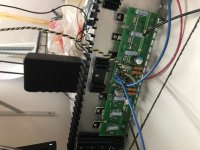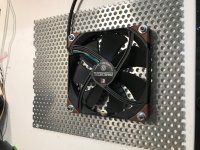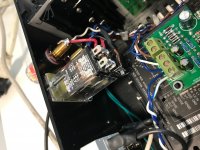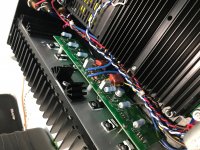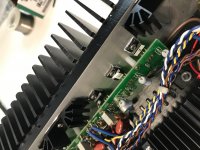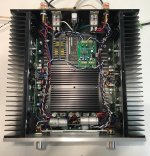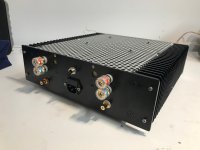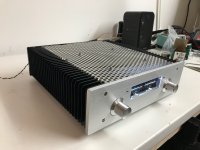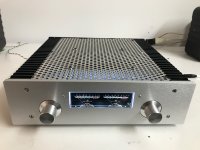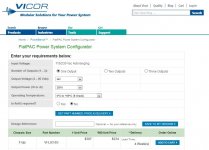Only if you know exactly what are you doing. Otherwise, you can damage it.1) With the FETs not installed yet, can I test the rest of the circuit?
Yes2) Is the gain of this amp the same as the regular F5 (15 db)?
Working
So I got both channels fired up, and working just fine!
Biased up and ran first with no load for a few hours on each channel, then connected to a test speaker. So far so good!!
Next I need to order a few more parts for the enclosure, and will do some more tests shortly.
The only thing of note is that I had to change R5 and 6 to 4k7 from 2k2 for it to bias up correctly. I read that from the main thread, so I think that is not a big deal. Once I made that change, biasing to within 2mv was not a problem.
So I got both channels fired up, and working just fine!
Biased up and ran first with no load for a few hours on each channel, then connected to a test speaker. So far so good!!
Next I need to order a few more parts for the enclosure, and will do some more tests shortly.
The only thing of note is that I had to change R5 and 6 to 4k7 from 2k2 for it to bias up correctly. I read that from the main thread, so I think that is not a big deal. Once I made that change, biasing to within 2mv was not a problem.
Attachments
Finished!!!
Finished, and sounds great! I've only been listening to it on real speakers for a few hours, but it sounds pretty great so far. Here are some pics.
A few tech details:
I'll keep it running for the next few days, and post some impressions later. Thanks Juma for posting this really interesting variation and for yours and everyone's help!
Finished, and sounds great! I've only been listening to it on real speakers for a few hours, but it sounds pretty great so far. Here are some pics.
A few tech details:
- 15V, 3 pairs @ 400ma. Exactly half the heat dissipation of the real F5
- Using a SMPS, absolutely silent. Ears up to speakers and can't hear a thing.
- Amp running a bit hot. Nothing to totally worry about, but I added a 140mm fan running @ 8v. I know the perf metal is blocking half the air, but it's amazing how much the fan cooled things down- even though not blowing on the heatsink fins.
- Since I'm using a dual SMPS, my only fear is what happens if one rail goes for some reason. So I used a relay on each speaker, where I ran +15 to one end of the coil, and -15 to the other, with a resistor to knock the voltage down to 24V across the coil. This way, speakers are only connected if both rails come up. Pretty remedial speaker protection, but seems to work pretty well.
I'll keep it running for the next few days, and post some impressions later. Thanks Juma for posting this really interesting variation and for yours and everyone's help!
Attachments
Great job Anchan, glad you like it ! Looks nice and compact. 
As for checking what happens if one rail goes down - connect the 4R-8R power resistor instead of speaker at the output and make sure that you have a fuse in SMPS's primary side. Then disconnect one rail and observe what happens at the output. IME, you'll get strong distortion (because only half of the output stage is working) and the DC voltage at the output will be less then 1V so no real danger for the speaker.
The same happens if the power rail gets shorted to ground plus you'll lose the fuse...

As for checking what happens if one rail goes down - connect the 4R-8R power resistor instead of speaker at the output and make sure that you have a fuse in SMPS's primary side. Then disconnect one rail and observe what happens at the output. IME, you'll get strong distortion (because only half of the output stage is working) and the DC voltage at the output will be less then 1V so no real danger for the speaker.
The same happens if the power rail gets shorted to ground plus you'll lose the fuse...
Thanks! It's about as compact as possible. Another cm to two shorter, and I think I would have run out of room, and heat! But it was just enough.
Didn't realize that about the rails. Good to know. Maybe I didn't need those relays after all. Gives a nice delay-on though for effect.
Didn't realize that about the rails. Good to know. Maybe I didn't need those relays after all. Gives a nice delay-on though for effect.
Great job Anchan, glad you like it ! Looks nice and compact.
As for checking what happens if one rail goes down - connect the 4R-8R power resistor instead of speaker at the output and make sure that you have a fuse in SMPS's primary side. Then disconnect one rail and observe what happens at the output. IME, you'll get strong distortion (because only half of the output stage is working) and the DC voltage at the output will be less then 1V so no real danger for the speaker.
The same happens if the power rail gets shorted to ground plus you'll lose the fuse...
So I've been listening for about a week now, and I'm definitely enjoying. Some really great bass, and with electronic music, which I love it sounds amazing.
But on some music, basically anything with a lot of high hat, cymbals, or shakers, it really dominates the mix. There's a whole of lot of shimmer to everything. It's a little intense sometimes. Maybe it's just the combination of this amp with my speakers which have a ribbon tweeter. Also for 6 years, I've been listening to the only other amp I've built, which is a variation of tubelab's simple SE. Skip to the end of the thread.
Dual Simple SE's in Push Pull w Differential Input
I'm sure the tube amp rounded off a lot of the edges, and I'm sure this amp is more accurate.
It's a pretty massive difference in sound between the two amps. Just for fun, I was thinking about using the tube amp as a preamp and running into this one. The tube amp has barely 6db gain, so I wouldn't be wasting too much gain. I realize I have to load the tube amp to try this. Anyway, just an experiment for fun.
But on some music, basically anything with a lot of high hat, cymbals, or shakers, it really dominates the mix. There's a whole of lot of shimmer to everything. It's a little intense sometimes. Maybe it's just the combination of this amp with my speakers which have a ribbon tweeter. Also for 6 years, I've been listening to the only other amp I've built, which is a variation of tubelab's simple SE. Skip to the end of the thread.
Dual Simple SE's in Push Pull w Differential Input
I'm sure the tube amp rounded off a lot of the edges, and I'm sure this amp is more accurate.
It's a pretty massive difference in sound between the two amps. Just for fun, I was thinking about using the tube amp as a preamp and running into this one. The tube amp has barely 6db gain, so I wouldn't be wasting too much gain. I realize I have to load the tube amp to try this. Anyway, just an experiment for fun.
Hi Anchan,
it's interesting to see again how our habits can dominate our senses. You can experiment with low pas filter at the input of the amp or add some caps over the feedback resistors to strangle the amp's frequency response down to 12-15 kHz and it will sound more like your tube amp with output transformers. Absolute accuracy is not more important than your preferences.
Make it enjoyable for yourself
it's interesting to see again how our habits can dominate our senses. You can experiment with low pas filter at the input of the amp or add some caps over the feedback resistors to strangle the amp's frequency response down to 12-15 kHz and it will sound more like your tube amp with output transformers. Absolute accuracy is not more important than your preferences.
Make it enjoyable for yourself

Yes indeed, it is interesting how our ears and brain are an equal part of the equation. I'll play around a bit, and also continue to listen as is and see what my experience is.
I also think the speakers are huge part of it too. The top end, being ribbons, might accentuate the highs as well. Even good speakers are not always benign.
I also think the speakers are huge part of it too. The top end, being ribbons, might accentuate the highs as well. Even good speakers are not always benign.
So, I've been listening to this amp for a week straight, and I have to say it is sounding quite wonderful. After my ears and brain have adjusted to all the high frequencies I've been missing with my tube amp, I'm starting to hear things in a different light.
I still love my 6V6 amp, but this is quite different and lovely. They each have their strengths and weaknesses.
Now I'm curious how this amp compares to the original regular F5. Would love to hear a few impressions from those who have heard both.
I still love my 6V6 amp, but this is quite different and lovely. They each have their strengths and weaknesses.
Now I'm curious how this amp compares to the original regular F5. Would love to hear a few impressions from those who have heard both.
...
Now I'm curious how this amp compares to the original regular F5. Would love to hear a few impressions from those who have heard both.
Hi Anhcan, very nice build!
Comparison to standard (DIY) F5 with IRFP's and Juma's version with 2SK/2SJ: What I remember as first impression (less than a week between listening 'old' & 'new')
was that F5 w/ IRFP's had some grain, like in good but not perfect b/w photo. I did not noticed that 'grain' in sound until listening the new, Juma's version. Is it because
of output transistors not being 'Fairchild' one's or because of cap multiplier -not used in first F5 iteration, simply don't know. Both versions were built as dual-mono and
used same 2x200VA toroids. Never used SMPS for power supply, think I never will. Must say again: First F5 was my build while the second one was fully completed by
my good friend, locally nicknamed 'Sipi' and also known as - 'Juma'. Hello Juma!
Best regards to both,
George
I wonder if "graininess" of sound is proportional to third harmonic distortion relative to second harmonic? Measure the amps and you will know the difference.
Here is a Class A amp with adjustable "grain" knob.
http://www.diyaudio.com/forums/soli...ifier-trilogy-plh-jlh-amps-8.html#post5179107
Here is a Class A amp with adjustable "grain" knob.
http://www.diyaudio.com/forums/soli...ifier-trilogy-plh-jlh-amps-8.html#post5179107
Hi X,
Interesting link. The PCB's Anchan used for his build are boards that late Georg ('permaneder') designed and if I remember well (should be described
in this topic somewhere) his boards also contain (place for) trimmer with exactly the same role - adjusting H2/H3 level/proportion(s).
Brgds.
Interesting link. The PCB's Anchan used for his build are boards that late Georg ('permaneder') designed and if I remember well (should be described
in this topic somewhere) his boards also contain (place for) trimmer with exactly the same role - adjusting H2/H3 level/proportion(s).
Brgds.
As nik_d said, so called "sound grain" is a property of many HEXFET amps. People are mostly not aware of it until they compare such an amp with another one, free of that effect. Sometimes it helps to bias them high but in the case of F5 only getting rid of HEXFETs really helped (turning a P3 knob just changes from one shade of grey to another) - that's why I used far more linear k2013/j313, it made it a much better sounding amp. k1529/j201 bring an improvement too. Laterals/F7 is another good way to go in this case.
I really love F5 topology, it's a beautiful design but HEXFETs are the bottleneck (IMO).
Using BJTs in the input stage to achieve higher OLG and driving the output from emitter follower stage also brings interesting results - the playground is wide here...
I really love F5 topology, it's a beautiful design but HEXFETs are the bottleneck (IMO).
Using BJTs in the input stage to achieve higher OLG and driving the output from emitter follower stage also brings interesting results - the playground is wide here...
Input LP filter
Some more listening impressions:
Really enjoying this amp, wow, wow and wow.
But with ribbon tweeters, honestly there is just too much detail in this highs for my system or for me. It's like looking at a beautiful photograph on an 8K monitor, with the brightness turned up. You can see the jpeg compression, sharpening artifacts etc. Sometimes it's too much. Mostly I hear how everything is recorded, and that is not always a good thing.
I did an experiment where I just loosely taped a piece of paper towel over the ribbon, just to dampen the highs, and it really solved everything. Way better- everything in its place now.
So I'll experiment with a simple RC filter at the input. I was thinking of a small 1K pot and .02uF cap right after the rca jack. I think this should let me dial it in, and if I ever change speakers, it will be an easy adjustment.
Some more listening impressions:
Really enjoying this amp, wow, wow and wow.
But with ribbon tweeters, honestly there is just too much detail in this highs for my system or for me. It's like looking at a beautiful photograph on an 8K monitor, with the brightness turned up. You can see the jpeg compression, sharpening artifacts etc. Sometimes it's too much. Mostly I hear how everything is recorded, and that is not always a good thing.
I did an experiment where I just loosely taped a piece of paper towel over the ribbon, just to dampen the highs, and it really solved everything. Way better- everything in its place now.
So I'll experiment with a simple RC filter at the input. I was thinking of a small 1K pot and .02uF cap right after the rca jack. I think this should let me dial it in, and if I ever change speakers, it will be an easy adjustment.
- Question: I have a 10K volume pot at the input of the amp as well as the usual 1K / 100K input resistors. If I put the filter before the volume pot, that should be fine right? I'm not certain if the volume pot or other resistors interfere with the RC calculation.
- One other question: Why don't more people use (good) SMPS's. Not the noisy crappy kind. But there are others. The unit I used measured 25mv ripple @ 250kHz, absolutely nothing below 100k. No huge transformers, cap banks etc. Also, even under intense load, the voltage doesn't budge even 100mv. What could be better?
http://www.vicorpower.com/flatpac
You can pick them up on EBay all day, cheap.
You can pick them up on EBay all day, cheap.
Dear Anchan:
Interesting info on the SMPS there.
What make and model are you using ?
Best regards,
Claas
We surely don't have same criteria about "cheap"
Your link shows flatpack SMPS 24V/200W with a 1 unit price set at $307 and 2 x 24V/2 x 200W dual output unit costs $567. That amount of money buys a couple of great linear PSUs ...
Attachments
- Status
- This old topic is closed. If you want to reopen this topic, contact a moderator using the "Report Post" button.
- Home
- Amplifiers
- Pass Labs
- F5 with 2SK2013/2SJ313
